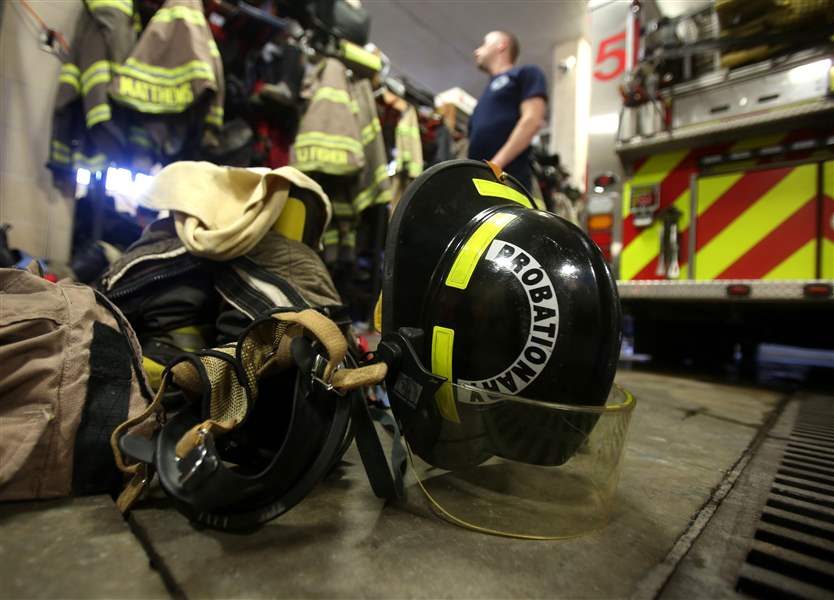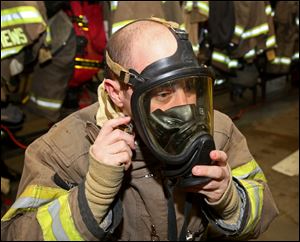
Toledo firefighters participate in cancer study
12/14/2017
Pvt. Erin Martens, with the Toledo Fire Department, demonstrates the steps in putting on his turnout gear at Fire Station 5 in Toledo on Thursday.
The Blade/Kurt Steiss
Buy This Image
Toledo firefighters are participating in a study to better understand the relationship between firefighting and cancer while department leaders evaluate their own practices in an effort to better protect their own from long-term negative health consequences.
The study, conducted by researchers at Ohio State University, is part of a wider effort to see how fighting fires physically impacts firefighters’ health. In addition to participating in the upcoming study, Toledo firefighters are taking steps — such as washing turnout gear after every fire or requiring hand washing before restroom use after a call — that will hopefully make a big difference.

Pvt. Erin Martens, with the Toledo Fire Department, demonstrates the steps in putting on his turnout gear at Fire Station 5 in Toledo.
“For us older guys who have been around a while, we can’t take back the things we’ve already done. We just have to get better on this point forward and move on and keep getting better. That’s why this study is going to be so huge because the new people coming on will benefit from this,” Toledo Fire Department Capt. Matt Brixey said.
The National Institute for Occupational Safety and Health in 2010 began a multi-year analysis of nearly 30,000 firefighters who served in Chicago, Philadelphia, and San Francisco. Completed in 2015, the study suggested firefighters have higher rates of certain types of cancer — and cancer-related deaths — than the general population. Digestive, oral, respiratory, and urinary cancers proved particularly problematic, the study found.
The study also found firefighters suffered from higher rates of malignant mesothelioma, a rare type of cancer caused by exposure to asbestos; firefighters younger than 65 had higher rates of bladder and prostate cancer than expected; the chance of lung cancer diagnosis increased with the amount of time spent at fires, and the chance of leukemia death increased with the number of fire runs.
“This study provides further evidence that [firefighters] are at increased risk of certain types of cancer as a result of occupational exposure,” a summary of the study’s findings said.
When Captain Brixey and Toledo Fire Department spokesman Pvt. Sterling Rahe began their careers nearly 18 years ago, ways to protect fire crews from potentiality cancer-causing hazards weren’t discussed.
“It’s such a cultural change from when we came on,” Private Rahe said. “That whole thought process of it was always a badge of honor to have the dirtiest gear or the dirtiest helmet — that has shifted in a positive fashion to the other end of the spectrum.”
The Ohio State researchers will collect specimen samples from firefighters across the state to better analyze how occupational exposures increase cancer risk, said Susan Olivo-Marston, an associate professor and co-director of the public health honors program.
“We believe this study is important because we really don’t know what the increased cancer risk is for firefighters and how certain things they are exposed to may impact that risk,” said Ms. Olivo-Marston
Thirty-five Toledo firefighters have signed up to be part of the Ohio State University study, which will include a baseline of a skin swab, a urine sample, and a blood sample, Captain Brixey said. Six of those firefighters will then provide samples three times — immediately, 6 hours, and 24 hours following a fire.
Firefighters from Toledo, Columbus, Dayton, Cincinnati, and smaller departments around central Ohio are participating in the study. Researchers are evaluating firefighters with and without cancer.
“This may take years to actually pinpoint what’s giving us that higher risk,” Captain Brixey said. “This study is one of the firsts to take that step — identifying what is actually in our blood and on our skin.”
The study should be completed in approximately a year and a half, Ms. Olivo-Marston said.
A peer-reviewed journal will be published following the study.
Contact Allison Reamer at areamer@theblade.com, 419-724-6506 or on Twitter @AllisonRBlade.